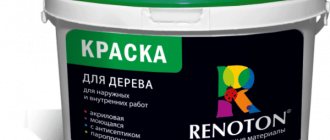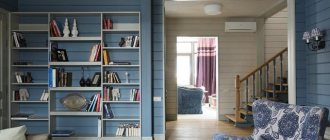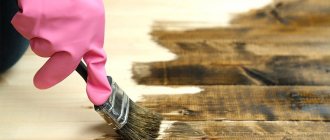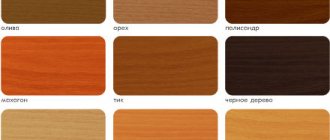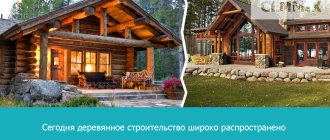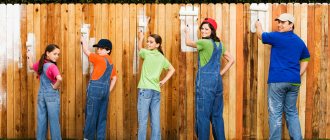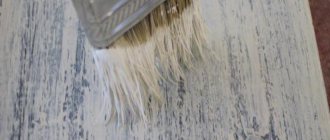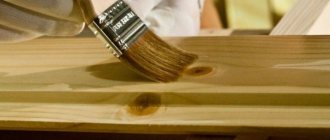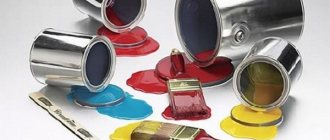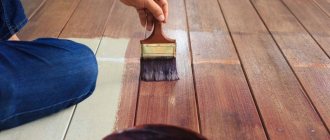Parquet is considered the most beautiful and durable among floor coverings. Its popularity is due, first of all, to its environmental friendliness, which is greatly facilitated by the paint and varnish materials applied to the surface. The best health safety indicators are demonstrated by odorless parquet varnish, which, thanks to its unique characteristics, is in an advantageous position in comparison with other compositions. Not only does it not smell, but it also has excellent drying speed and is resistant to wear and moisture.
Types of water-soluble varnishes
Depending on what binder is used in the solution, the following varieties are distinguished:
- one-component: acrylic and polyurethane;
- two-component.
Acrylic
These solutions are the easiest to apply. In the transport container they are a white liquid. When applied, the result is a transparent coating that has no color. By type of application they are considered universal.
The presence of an acrylate base dissolved in water made it possible to get rid of the odor. Treated surfaces are well preserved in the sun and in humid microclimates. Acrylic varnishes are not very thick, so the consumption is low. Painting available in a large number of color options.
Examples of acrylic varnishes:
- The cheapest and most popular type of acrylic varnish is Ballet parquet varnish. It does not pose a danger to people and animals and does not burn. Can be used to produce matte, semi-matte, glossy and multi-colored surfaces.
- English Dulux is resistant even to abrasive loads, household chemicals, alcohol, and is not afraid of hot water.
- Domalux water-based acrylic varnish for wood allows you to complete work in a short time due to its quick drying. The coating it creates has a beautiful natural look and glossy shine. Its safety for humans and animals is simply amazing. It can be used for coating in medical institutions; it can be used to paint children's toys. Acrylic solution increases the service life of the product and wear resistance. The disadvantage is that it cannot be used in conditions of high humidity.
Polyurethane
These varnishes contain ultraviolet absorbers. The film they form on the surface has high resistance to friction and impact, which gives the products wear resistance. In addition, this product can be used in conditions of high humidity.
After using this varnish, no streaks remain and no yellow tint is formed during use. It dries quickly and gives the coating a special gloss. Protects product surfaces from destruction by alcohols and chemicals.
These self-leveling varnishes are designed to create durable, smooth and transparent surfaces. They dry in 2 hours and show their protective properties better when applied in 3 layers.
Example: Finnish products Tikkurila. This acrylate varnish is diluted with water and has a polyurethane base. The product is so unique that it allows any customer to choose their own color. Using the code, it is subsequently possible to purchase varnish of exactly the same shade and quality. The technology is called computer tinting.
Two-component
These varnishes come in two containers. The components are mixed immediately before use and the finished varnish cannot be stored for a long time. The hardener contained in its composition gives the painted surface special strength and allows the use of varnish coating for objects that are subject to heavy loads.
As an example, consider alkyd-urethane varnish from Tikkurila. It consists of two components that are mixed before application. Leftovers after work are stored in carefully closed containers for a very short period of time.
It is worth paying attention to the quality of mixing of components, which affects the created coating. For mixing, use a low-speed drill.
The coating becomes high-quality two weeks after application; during this period it is treated with care. Immediately after work, all tools are thoroughly cleaned with detergents - if this is not done immediately, then the remaining paint will not be removed.
Alkyd-urethane
Alkyd-urethane type varnishes are used for application to wooden products. They have no hue or odor, but due to dilution with white spirit they can give off an unpleasant odor of petroleum products. As it hardens, a beautiful gloss forms. Drying a layer of alkyd-urethane varnish occurs in just 2 hours, but subsequent layers can only be done after a day.
Acrylate
Acrylate varnishes are diluted with water; the compositions withstand high temperatures and moisture. The products have no color: the varnishes are completely transparent, so they can be applied over paints and stains. The main area of application is varnishing wooden walls and ceilings, wood panels, particle boards in saunas.
Types of colorless varnishes depending on the base with description
Matte, colorless, or glossy varnish for wood can be made from different components; the included substances affect the technical characteristics of the varnish:
- With epoxy resin in its composition, a universal option for processing objects inside and outside the building, reliably protects the base from moisture, shock and other influences, dries quickly;
- With polyurethane, also universal. A durable coating is created, suitable for protecting yachts, furniture, floors and other surfaces;
- Oil-based, used for indoor work, the layer is hard and moisture-resistant;
- Alkyd, they are fire resistant, wear-resistant, durable, the varnish has a strong smell;
- Based on acrylic and water, safe, resistant to moisture, used indoors, odorless;
- Nitrocellulose, quick-drying, medium strength, strong smell, for interior use, but not used for varnishing floors.
The acrylic type can be called an odorless, quick-drying wood varnish.
Matte, colorless, or glossy varnish for wood can be made from different components; the included substances affect the technical characteristics of the varnish.
Some application features
The coating technology does not differ from the traditional one. You can perform the work using a roller or brush.
Important! Water-based varnishes must be stored in heated areas.
Features of the work:
- Work is carried out at temperatures of 18-20°C and humidity more than 50%. Lower temperatures slow down the drying process, which can negatively affect the appearance of the coating. In dry air, drying occurs very quickly, which is also an unfavorable factor.
- Before starting work on a separate area, the compatibility of the material with the previously applied coating is checked.
- When drying, drafts and direct sunlight are not allowed.
Two-component formulations
These products are the most durable, reliable and wear-resistant. The varnish has excellent adhesion to any type and species of wood, resistance to specific climates, low water absorption coefficients, and high elasticity.
But when choosing such a material, you should think it over carefully and familiarize yourself with practical recommendations for choosing varnish for parquet. Experts advise applying these compounds only to dried parquet. If the wood does not have a low enough humidity, then small bubbles will form on the surface - such a floor will have to be repainted.
Application technology
Before work, you must carefully read the instructions. Some varnishes have nuances in use, which the manufacturer always warns about.
Coating technique:
- Preparatory stage. The surface must be carefully leveled and sanded. There should be no chips, holes, or other defects, especially on furniture or floor coverings. Large defects are puttied with a special wood product.
- Main stage. Apply varnish to the base using a roller or brush. If the treatment area is large, use a spray gun. Start from the edge, making movements to the opposite edge according to the location of the wood fibers. The number of layers is from two to five. Before each subsequent layer, sand the previous one a little with fine sandpaper - this will enhance adhesion.
It is important that when applying varnish the humidity is no more than 50%, the temperature is about +18...+23 degrees, there are no drafts, and direct sunlight is excluded. Drying time is indicated in the instructions, usually 2 – 24 hours. Carpets can only be laid on the floor a week after painting.
Tips for caring for varnished floors
Varnishing parquet is a rather labor-intensive and time-consuming process. Therefore, it is important to keep the varnish coating in its original form for as long as possible. In this regard, here are a few tips that will help preserve the coating for as long as possible:
- after the last layer of varnish has dried, you should not walk on the floor for several more days;
- if you plan to cover the surface with carpet, then you should wait at least 10 days for this;
- We glue felt attachments onto the furniture legs from the end;
- At least once a year it is necessary to carry out control varnishing in one layer. You can use quick-drying varnish for this.
When starting the varnishing process, be sure to pay attention to the composition of the varnish. And following the advice on the technology of its application, we will get not only a parquet floor, but a floor covering of the highest quality. In addition, you can use this type of varnish for laminate flooring, thus protecting its surface from damage during operation.
Selection rules
High-quality material will last longer and provide better decorative and protective properties. When choosing, you need to be guided by the following points:
- Wear resistance. If the level of load on the base is regularly high, you need to buy a product with excellent resistance to wear, friction, and mechanical damage.
- Fire safety. Wood ignites quickly and burns well, so the varnish must increase the heat resistance of the material and prevent fire.
- Compound. There are two-pack formulations that must be mixed before application, and there are also ready-to-use products. When purchasing, it is important to take into account convenience and the fact that after mixing it will not be possible to store the varnish for a long time.
- Type of varnish. Some materials traditionally give a shiny, glossy sheen, but there are also varnishes that have a matte effect.
- Drying time. Varnishes diluted with water dry quite quickly, but the drying period may vary depending on the composition.
- Moisture resistance. Not all varnishes can protect wood from water. It is better to buy polyurethane compounds if you need to use the product for wet areas.
Odorless varnishes can be used to cover windows, doors, and other wooden products. The products are universal and last for a long time.
How to repair a floor surface yourself
Having decided what composition you need to purchase to make it beautiful, durable and inexpensive, you can begin finishing the floor with your own hands. For this you need such tools.
- Polishing machine. You can purchase it, but it will be cheaper to rent, because if all the work is done correctly, you will not need the device again soon.
- Abrasives of various denominations, but the presence of the highest and softest number is mandatory.
- Spatulas.
- Application tool. The varnish is best distributed with a roller, but you need to stock up on various brushes for coating corners and hard-to-reach places.
- Soft cloths to remove excess composition.
- Cleaning equipment to remove all dirt before work.
Preparation
Necessary conditions for quality work:
- The room must have a temperature corresponding to the parameters specified in the instructions for the purchased mixture. Exceeding or failing to achieve these parameters will affect the quality of the final result (strength, durability).
- Humidity. High humidity is needed only for water-soluble mixtures; for others it causes problems with drying and the formation of a protective film. When used for outdoor work, this will be precipitation.
- Drafts. Ventilation is allowed only when working with acid-curing compounds; in other cases, this leads to a deterioration in the quality of the work performed.
Operating procedure
How do you do a DIY repair?
- First, the surface is properly prepared. To do this, you need to clean it from dirt and remove the old coating. Removal of the previous layer can be done using a spatula or a grinder (grinder).
- After removing the old decorative layer (if restoration was carried out), the surface is cleaned using a grinder with a special attachment or sandpaper of varying softness. All irregularities must be removed.
- If the floor is old, after removing layers of peeling paint, it must be leveled using putty or sanded.
- You can scrape the floor surface yourself or enlist the help of an experienced craftsman. But it is worth remembering that if you fail to cycle correctly, the parquet will be damaged. Maybe it would be more profitable to hire a specialist?
- After this, it is necessary to remove all debris; to improve the quality, it is even better to wash such a floor, but then you need to let it dry.
- Now, if the floor is old, uneven or the wood needs protection, you need to apply a coat of primer. It is applied with your own hands using a spray gun or roller, and hard-to-reach places are painted with a brush. All excess, no matter how much there is, must be removed with a soft cloth.
- Now you can open the jar of varnish or mix the ingredients (if two-component mixtures are used). If desired or necessary, do the tinting yourself after opening the paint can.
- It is better to apply the product after preparing and washing the surfaces with a roller, working parallel and perpendicular, applying the composition in one direction and leveling it in the other. As it dries, you need to apply as many layers as recommended in the manufacturer's instructions or a little more.
- After this, after a day or more, depending on the speed of drying, you can vacuum and wash the floor. Further surface care will be simple.
Possible problems during application
Sometimes there are problems with the coating. This happens for the following reasons:
- The varnish does not dry. It either does not suit the type of wood used, or requires a different drying temperature. If it doesn’t fit, you will have to remove it, remove it with a sander, and then apply it again. If the problem is temperature, then it should be brought to the required minimum.
- There was not enough hardener in the two-component varnish. In this case, it is necessary to remove (by sanding) the unsuccessful coating and apply it again.
When deciding which varnish to choose for repairs, each owner will be able to choose one that will be economical, easy to maintain and relatively durable. Perhaps it is worth buying a more expensive composition that will protect and decorate wood for several years, rather than purchasing a cheaper one for a year? How much extra expense is this?
Properly coated floors will only need to be washed for several years; they do not require much maintenance. The main thing is not to be lazy and apply as many layers of the product as shown in the instructions, or 1-2 more.
The best manufacturers
In any building materials store you can find varnishes of the Russian brand Technocolor. The brand produces water-based polyurethane and acrylic varnishes for wooden products, which are widely used for processing furniture, flooring, and stairs. Technocolor varnishes do not contain components harmful to health, they can even be used in children's rooms.
The most famous products in the line:
- HTL 20030. Varnish application technique - dipping or spraying. Popular for any wooden products.
- HTL 20 SM. It is highly resistant to UV radiation, does not turn yellow over time, and can be diluted with water.
- ATL 200. Particularly resistant to chemicals, easily withstands wet cleaning, recommended for floors and furniture.
The Finnish brand Tikkurila stands out for its excellent product quality. All products are made taking into account innovation and testing with computerized installations. Tikkuril polyurethane varnishes have the highest resistance to friction and can withstand the ingress of any chemicals, except nitro solvents.
The varnishes from Bona (Sweden) are odorless and water-based. They are recommended for use in rooms where a large number of people regularly pass (for example, in museums). Long-term preservation of an attractive appearance is due to high wear resistance.
No less famous among professionals are the German varnishes Berger and Lobadar - glossy, semi-matte, matte, with good protection against abrasion.
Rustins antiseptic varnish - Polyuretahane Varnish - is produced in transparent and colored variations. Contains antiseptic additives that help protect wood from insects, fungus, and mold.
One-component water-polyurethane compositions
These products are intended for use on floors with moderate traffic. The cost of these materials is reasonable and they are very easy to apply. These varnishes are an ideal choice for those rooms where low traffic and wear are not a priority.
There are also single-component materials. They can be used under conditions of high and maximum loads. At the same time, there is no toxic odor, and the drying speed is very high. These varnishes are the most common among the entire range.
What to do if there is still an unpleasant odor?
If you choose a non-water-based varnish, a few tips will help get rid of the strong odor:
- Activated carbon and regular table salt have adsorbing properties. Pour them into plates and place them in a room where there is a painted surface. You can also make an aqueous solution of these substances - the effect will be the same.
- If the painted surfaces have already dried, but continue to emit an odor, you can use an old cloth, which you need to wet and hang around the room.
- Onions and garlic also absorb odors well. They need to be grated or cut and placed on plates. Overnight is enough for the herbal helpers to remove all the odor.
- Candles or bags with aromatic herbs, a few drops of aroma oil, which need to be dropped onto the incandescent lamp before turning it on. These products will eliminate the unpleasant smell of varnish.
But it is better to choose modern, odorless, water-based varnishes - materials that expand the concept of repair. Work can be performed in residential premises without disturbing the usual rhythm of life.
comparison table
Based on the rating compiled above, we organized the main technical parameters of varnishes and placed them in a table. With this organized information, you can track down the most suitable remedy for yourself.
| Name | Shine | The basis | Weight | Price, rub) |
| EUROTEX | semi-gloss | acrylic | 2.5 | 400 – 850 |
| TEX Pro | glossy | acrylic | 2.5 | 650 – 1 200 |
| VGT | glossy | acrylic | 3 | 350 – 700 |
| Dulux Diamond Glaze | glossy | acrylic-urethane | 0.9 | 480 – 650 |
| Tikkurila | glossy | acrylic | 2.7 | 500 – 680 |
| Parade | glossy | acrylic | 2.6 | 800 – 1 100 |
| Dulux | semi-gloss | alkyd-urethane | 2.5 | 400 – 600 |
Deception is everywhere
Which quick-drying varnish to choose for parquet? Any quality product, just not the kind sold in plastic buckets or other bulk containers.
Companies BONA, LOBA, FORBO and others pack varnish in a plastic or tin canister with a volume of 5 or 10 liters. The same goes for prices. A high-quality two-component composition cannot cost 300 rubles per liter.
